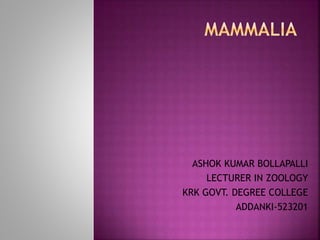
Mammalia.pptx
- 1. ASHOK KUMAR BOLLAPALLI LECTURER IN ZOOLOGY KRK GOVT. DEGREE COLLEGE ADDANKI-523201
- 2. Endothermic terrestrial Vertebrates that dominated during Cenozoic era Originated from theropsid reptiles in Triassic period Occupy the top of evolutionary ladder due to their superiorly organized brain Largest mammal- Balanoptera musculus- 35 meters long and 120 tones weight Largest land dwelling mammal- African Elephant- Elephus maximus Longest Mammal-Giraffe-16 feet- Giraffa camelopardalis Smallest mammal- Etruscan Pygmy Shrew Bumble bee bat
- 3. Endothermic/Homeothermic/Warm blooded Epidermal hair, spines, horns, hooves, antlers, nails, claws Integumentary gland- Sudorific/Sweat glands- Regulates temperature, Sebaceous glands-keeping the skin and hair soft Mammae- modified sudorific glands- helps to nourish the young one with nipples/ teats Diaphragm- muscular partition – separates thoracic and abdominal cavities-helps in breathing Dentition is- heterodont( Inscisors, canines, premolars and molars), diphyodont( teeth forms twice in the life-Milk teeth/deciduous teeth replaced by permanent teeth) and thecodont( teeth lodged in the deep sockets of the jaw bone)
- 4. Salivary glands in the buccal cavity are four pairs-parotid, Sub maxillary/Sub mandibular, Sub lingual and infra orbitals(absent in Man) Skull is dicondylic, Each half of the jaw bone is composed of a single bone, the dentary, articulating with the sqamosal of the skull, A bony secondary palate formed by the union of premaxillae, maxillae and palatine bones, separates nasal and oral passages. Vertebrae are with flat centrum(Acoelous/ Amphiplatyan). Ribs double headed, Cervical vertebrae are seven except in three toed sloth(9), two toed sloth(6) and manatee(6) Respiration is by lungs, glottis is guarded by a flap called epiglottis
- 5. RBC are enucleated, boconcave and circular except in Camels and Llamas where they are elliptical. SAN pacemaker, AVN- Ectopic pacemaker-behaves as pacemaker when SAN fails, Heart four chambered, double circulation, two aortic arches, Renal portal system is absent Kidneys are Metanephric. Excretes urea- ureotelic Cerebral hemispheres-large and exhibit convolutions. Carpus callosum- transverse band that connects cerebral hemispheres. Corpora quadrigemina- optic lobes four. Cerebellum is large, cranial nerves are 12 pairs Eyes are with lacrimal, harderian and meibomian glands whose secretions moisten and lubricate the conjunctival surface of the eye ball and its lids.
- 6. Ear is divided into three regions external ear/pinna- contains ceruminous glands in the auditory meatus- absent in monotremes, cetaceans and sirenians. Middle ear has three ossicles extending between tympanum and internal ear- Malleus, incus and stapes- stapes is the smallest bone in mammals. Internal ear has three semicircular canals and a watch spring like cochlea, conatining organ of corti Testes –scrotal sacs except in whales, elephants and in some insectivores and all prototherians Eggs are microlecithal or alecithal except in monotremates( Megalecithal) Holoblastic unequal cleavages Viviparous ( except in Prototherians- oviparous), placenta- helps in protection , nutrition respiration and excretion. Chorioallantic placenta in Eutherians and chorioyolksac placenta in marsupials, Gestation period- intrauterine period
- 7. It is classified into two sub classes Prototheria Theria Theria is subdivided into Metatheria and Eutheria
- 8. Reptile like, oviparous egg laying mammals with a variable temperature between 25-28 degrees Celsius Found in Australia, Tasmania, New Guinea No pinna on the ear in the skull tympanic bulla and lacrimals are absent; the jugal is reduced/ absent Teeth are present only in young ones adults are edentate and are with horny beak The pectoral girdle possesses large coracoid bones and T- shaped interclavicle. The pelvic girdle possesses epipubic bones, vertebrae without terminal epiphyses
- 9. The ribs are single headed Cloaca into which ureters and urinogenital sinus open Mammary glands are without nipples No corpus callosum The cochlea is a simple process of the sacculus and not coiled Testes are abdominal Females are oviparous
- 10. Modern viviparous marsupials and placental mammals Ear with pinna Mammary glands with nipples/ teats Dentate. Vertebrae with terminal epiphyses Cloaca is absent Testes are in scrotal sac. Vasa deferentia and air bladder opening through a common urethra in penis Ureters open into the base of bladder Oviducts open into a vagina It is divided into two infraclasses Metatheria and Eutheria
- 11. Marsupium/ brood pouch Mammary glands bearing nipples are sebaceous Epipubic bones are present and attached with the pubis Separate coracoid and interclavicle are absent Corpus callosum is feebly developed or absent Vagina and uterus are double/Didelphic condition Penis is bifid Placenta is rudimentary yolksac type Young ones are born extremely immature and crawl into marsupium attached with nipples for further development Confined to Australian region-Land of Marsupials
- 12. Didelphis (oppossum) Dasyurus(Tiger cat) Coenolestes( Opossum Rat) Notoryctes( Marsupial mole) Parameles ( Bandicoot) Macropus(Kangaroo) Phascolarctos (Koala)
- 13. Higher viviparous placental mammals Marsupium is entirely absent Epipubic bones are absent Cloaca is absent Corpus callosum is present Testes are usually contained in scrotal sacs Vagina is single Young one always nourished for considerable time in the uterus by means of chorio-allontoic placenta and born in a relatively advanced state Echolocation-emit ultrasounds to locate their way- Bats and whales
- 14. Insectivora( hedgehogs Shrews mole) Chiroptera (Bats and flying foxes) Primates( Man and apes) Edentata(sloth, Armadillos American ant eaters(Myrmecophaga)) Rodentia( Rat) Cetacea(Whales and Dolphins) Carnivora(Dogs,Cats Tigers Lion and bears) Sirenia(Manatees=Trichechus) Logomorpha (Rabbit) Pholidota(Manis(Pangolin/Scaly ant-eater))
- 15. Chordate Zoology E.L.Jordan and Dr.P.S. Verma S.Chand Publications Telugu Academy Zoology
